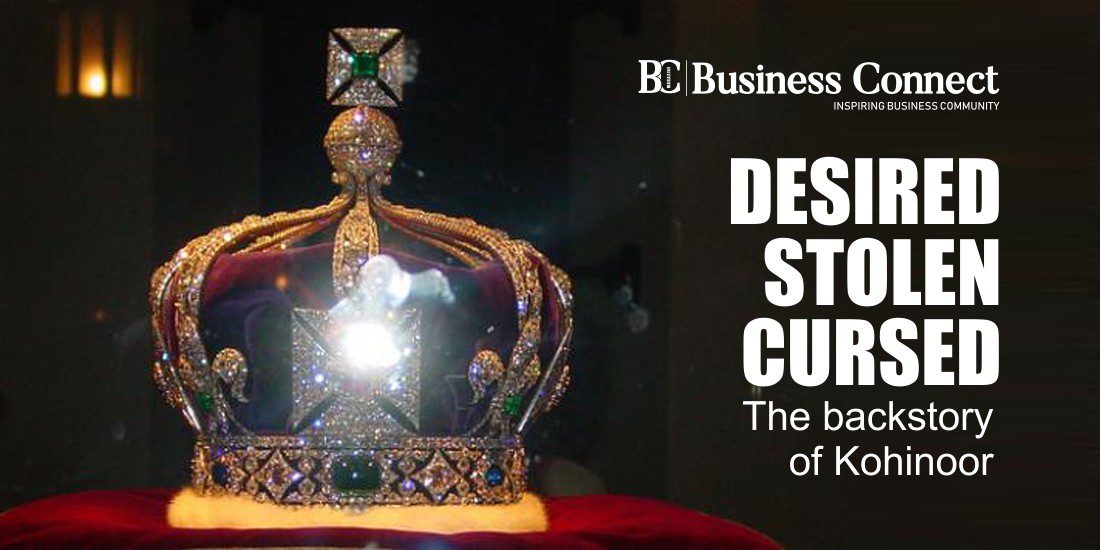Desired, Stolen, Cursed: The backstory of Kohinoor
The most famous but disputed diamond in the world, Kohinoor, is about to change hands. The diamond is currently set in the Imperial State Crown, which was made in 1937 for King George VI’s coronation and later given to Elizabeth II. The diamond will, however, be worn by the Queen’s daughter-in-law and Prince Charles III’s wife, Camilla Parker Bowles, during the coronation of the new King.
As the wife of King Charles III, Camilla has been crowned Queen Consort of the United Kingdom and 14 other Commonwealth nations. At King Charles’ coronation, the Crown of Queen Elizabeth, which currently wears the Kohinoor, will be placed on Camilla’s head. The crown, also known as the Queen Mother’s Crown, was made in 1937 for Queen Elizabeth, the wife of King George VI, and she continued to wear it after her daughter Elizabeth II became the monarch. The Kohinoor diamond, which is the most well-known of the 2,800 diamonds on the Crown, is set in platinum.
Currently, the British Royal Crown Jewels are all on display in the Jewel House at the Tower of London, including the Queen Mother’s Crown. The crown jewels are actually owned by the British monarchy and never pass into private hands. As a result, even though Camilla will wear it during the coronation, it remains a public heirloom.
Origin of the Koh-i-Noor
The Koh-i-Noor diamond is one of the biggest and most well-known cut diamonds in the world. Most likely, it was discovered in southern India between 1100 and 1300. The name “Mountain of Light” refers to the stone’s incredible size, which was originally 186 carats in weight(today 105.6).
India’s recently created Telangana state’s Golconda region is well known for its diamond mines. They have created some of the world’s finest jewels. Golconda, also known as Golla konda (“shepherd’s hill”), was the centre of mediaeval Golconda in Southern India. The location is 11 kilometres west of Hyderabad. The most well-known gems, including the “Hope Diamond,” “Idol’s Eye,” and most famous “Koh-i-Noor,” have come from this region of India, which has abundant gold and diamond deposits.
History of Koh-i-noor
The Kohinoor was created in Golconda, India. In particular, the Rayalaseema diamond mine denotes the “Land of Stones,” and it was found during coal mining in the Kollur mine during the Kakatiya era. At that time, it started changing hands between governing dynasties.
The stone first appears in written history when it belonged to Babur (1483-1530), the Mughal Empire’s first emperor and a direct ancestor of Genghis Khan (1162/67-1227), the Mongol emperor. The diamond was probably acquired as a war spoil, a fate it would experience several more times over the course of its long history and association with rulers. It is mentioned in the Mughal emperor’s memoirs, which he wrote in 1526. The stone, according to Babur, is “worth half of the daily expense of the entire world.”
When the Persian king Nader Shah (1698-1747) attacked and captured Delhi in 1739, he took possession of the diamond, despite the Mughal emperor’s attempts to conceal it in his turban. When Nader Shah first saw the stone, he called it a Koh-i-Noor, or “mountain of light,” and the name has stuck with it ever since. But its original name was “Samantik Mani,” which means “Prince and Leader of All Diamonds.
When Nader Shah died in 1747, his chief general, Ahmad Shah (1722-1772), claimed the precious stone and established the Durrani Dynasty of rulers in Afghanistan. The Durani eventually lost power, and Shah Shujah of the dynasty (l. 1785-1842) was forced to flee to India in 1813, when he gave the diamond as a gift to Maharaja Ranjit Singh, the ruler of Punjab (1780-1839).
Maharajah Duleep Singh (1838-1893) inherited it when he was only five years old, but he was to be the last ruler of the Punjab and Sikh Empire as the British Empire extended its tentacles into northern India. At the time, it was prized as a symbol of an Empire’s might. According to a popular proverb, “He who has this diamond will own the world, but will also know all its misfortunes; only God, or a woman, can wear it with impunity.”
How the British East India Company managed to capture the ‘cursed’ Kohinoor:
During the Second Anglo-Sikh War in 1849 AD, Raja Ranjit Singh’s son Duleep Singh was forced to surrender the Sikh empire by the British army. Following that, the British Government in Lahore transferred ownership of the famous Kohinoor diamond to the British East India Company’s treasury.
It is said that Duleep Singh, who was 11 at the time, “surrendered” the Kohinoor diamond along with the Sikh kingdom to the British. The Kohinoor and Duleep Singh were given to Dr. John Login as guardians after the Sikh dominion was turned over to the British East India Company. Duleep Singh was convinced to accept Christ by Dr. Login. Although Peter Bance contends that the truth was very different from what people believed, Singh is frequently referred to as the “King Who Gave Away Kohinoor.”
The diamond was taken from the Sikh Empire’s treasury when Duleep Singh was 11 years old by Lord Dalhousie, the Governor General of India. In 1854, Duleep Singh met Queen Victoria and requested to see the diamond. The diamond was brought from the British treasury on the Queen’s instructions, Lady Login argued, so seeing it would not harm him. Bance narrated how Duleep took the diamond and carried it to the window. He raised his hand and muttered, “to Humble Majesty Kohinoor diamond,” as the diamond glistened in the sunlight, and this started the donation bid.
Calls for a Return Across the Globe
The Indian government has demanded the Koh-i-Noor be brought back to its country-of-origin many times. The stone became a representation of the nation’s independence from British rule, which was attained in the same year as the first such request, in 1947.
In 1976, a new participant entered the discussion when Pakistan’s then-prime minister Zulfikar Ali Bhutto demanded that the stone be given back to his nation. The gemstone is also claimed by Iran and Afghanistan. By no means have the demands for the Koh-i-return Noor’s to the continent subsided; in fact, in 2015, a group of Indian investors even started a legal procedure to get the diamondback. However, the British royal family has yet to part with this most renowned and sought-after of diamonds.
In 2010, 30-year-old Vinod Roshan D’souza wrote to the queen of the UK after writing to Barak Obama and UN. He got the following response- “The diamond could not be returned because it was given to the Queen as part of the Treaty of Lahore in 1849 and is currently set in Queen Elizabeth’s crown”, the ministerial support team informed.
FAQs
Q.1- Why is Kohinoor diamond cursed?
The gem has been traded throughout history between various Hindu, Mongolian, Persian, Afghan, and Sikh rulers who fought ferocious wars to possess it. Every prince who held the diamond would eventually lose his position of authority, if not his life. The stone was traded between rulers for more than 500 years during bloody battles and cruel uprisings. While possessing the Koh-i-noor Diamond, the Golconda kingdom (present-day Telangana, India), the Khilji, the Tughlaq, the Lodhi, the Mughal, the Maratha, the Persian, the Durrani, the Afghan Khanate, and the Sikh empires all fell one after the other.
Even world-level empires have fallen under the weight of the curse, demonstrating the extent of the curse’s power. The British East India Company has owned the jewel since the annexation and dissolution of the Sikh Empire. However, the east India company was utterly destroyed by the revolt of 1857 only 7-8 years after the jewel was looted. The stone was inserted into Queen Elizabeth, King George VI’s wife, in 1936.
(Later known as the Queen Mother). The Kohinoor diamond has always been given to the wife of the male heir to the British throne, showing that the British Royal family was aware of the Koh-i-noor curse. This practice dates back to Queen Victoria’s reign. It is currently displayed as one of the crown jewels of the British monarchy in the Tower of London Jewel House.
Q.2- Who gave Kohinoor to the UK?
It is said that Duleep Singh, who was 11 at the time, “surrendered” the Kohinoor diamond along with the Sikh kingdom to the British. The Kohinoor and Duleep Singh were given to Dr. John Login as guardians after the Sikh dominion was turned over to the British East India Company. Duleep Singh was convinced to accept Christ by Dr. Login. Although Peter Bance contends that the truth was very different from what people believed, Singh is frequently referred to as the “King Who Gave Away Kohinoor.”
Q.3- Why can’t India get Kohinoor back?
The diamond could not be returned because it was given to the Queen as part of the Treaty of Lahore in 1849 and is currently set in Queen Elizabeth’s crown, the UK ministerial support team said in a response of Mumbai resident Vinod Roshan D’souza’s query.
Must Read:-
- Top 10 Young Entrepreneurs in India 2022
- Upcoming Indian Web Series for 2022-23
- Top 10 Hospitals in India 2022
- Top 10 richest player of the world 2021
- Top 10 highest-paid Indian Athletes 2021
- Top 10 highest paid CEO in the World
- Top 10 richest person of India
- Top 10 Highest Paid CEOs of India
- List Of Most Followed Facebook Pages in 2022
- The Success Story of Jeff Bezos
- Success Story Of Elon Musk
- Top 10 Business Magazine In India
- Top 10 Business Newspaper In India
- Top 10 richest billionaires in the world 2021
- Upcoming English Web Series in 2021
- Top 10 Tourist Places in India, places to visit after lockdown





